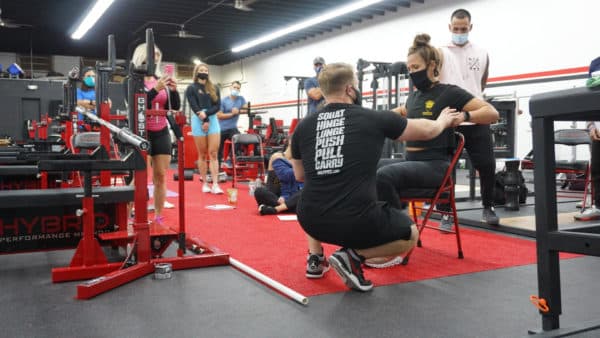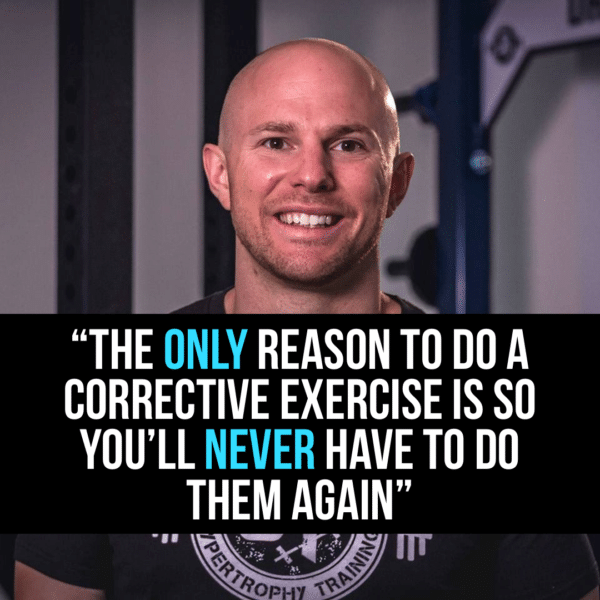WHAT YOU NEED TO KNOW
**Soft skills (communication, critical thinking, leadership, attitude, etc) are extremely hard to quantify but extremely important to develop in the health and wellness industry.
**The way you talk and interact with your clients will have a profound impact on their performance.
**Learning to be good with “soft skills” will take your clients success to another level.
**Using fear based language will only serve to leave your clients frustrated and feeling broken while also damaging your reputation.
**Although strength coaches are NEVER diagnosing or treating pain, the pain science research is the best place to look for understanding the impact of language.
Language, whether positive or negative, has a huge impact on us as human beings. This is even more apparent in the health and wellness space. For example, telling someone “you can” holds incredible power, as does telling someone “you cannot”. In this current climate of oversensitivity, understanding how to be a decent human being and actually demonstrate care for the people you work with will foster coach-client relationships that will last a lifetime. This includes everyone from non-clinical personnel such as personal trainers and strength coaches to clinical professionals such as physical therapists and medical doctors.
To understand how language (the input) affects performance (the output), a brief synopsis of the brain and central nervous systems must be understood. This specific topic could be (and is) an entire textbook by itself but that is not what we are after. It is important to note, nowhere in the PPSC do we recommend that non-clinical professionals attempt to diagnose or treat pain. If you cannot find a way to work around in training, then these individuals should be referred out to a rehabilitation professional. That being said, with the amount of evidence demonstrating increases in chronic pain, chronic disease and a population that is becoming more unhealthy by the day, we all have an OPPORTUNITY to alter the way we communicate with our clients/patients in order to get the best outcome available. As fitness and clinical professionals, we OWE it to the people we serve to be EXPERTS in knowing how to empower our clients and the people that put their trust and health in our hands.
Put simply, the brain regulates every single thing in your body. From the rate of your breath to the pace of your heartbeat, the brain is dictating it all. It is also directly involved in perception, and the ability to exhibit control over perception can go a long way in supporting longevity in the gym.
The most studied example of this is pain. It is extremely well known that pain is very subjective. A sensation perceived by one person as “painful” may not be perceived as painful by another. Pain is also multifactorial, meaning that many different inputs (such as past experience, expectations, personality) will have an influence on the output of pain. This has been reproduced with multiple studies. One study looked at soldiers injured in battle who reported less pain, and required less analgesia than civilians undergoing the same pain stimulus(1). It is also very well accepted that pain is not directly correlated with tissue damage (i.e. the more something is “broken” the more pain one feels). The best example of this is in the low back pain literature. Up to 9/10 cases of low back pain occur without a specific cause(2). If you want a more in-depth look at imaging findings and pain, refer to this 3,000+ word article I published in 2018 HERE.

It is also understood that pain perception is influenced by emotional factors such as attention, anxiety, fear, expectation and anticipation(3). To make this even more challenging, these factors are also modulated by an individuals’ past experience. The story below demonstrates a real-world example of how all of these factors can come together in the experience of pain. It this example does not drive home the power of perception, then I do not know what will!
A builder aged 29 came to the accident and emergency department having jumped down on to a 15 cm nail. As the smallest movement of the nail was painful he was sedated with fentanyl and midazolam. The nail was then pulled out from below. When his boot was removed a miraculous cure appeared to have taken place. Despite entering proximal to the steel toecap the nail had penetrated between the toes: the foot was entirely uninjured.
– JP Fisher, senior house officer, DT Hassan, senior registrar, N O’Connor, registrar, accident and emergency department, Leicester Royal Infirmar
The goal of this article is not to make anyone an expert or a psychologist but rather to appreciate the very complex interaction between perception, pain and performance. With that being said, here are actionable strategies that you can use TODAY with your clients to not only empower and support them but to also take their training to another level.
ACTIONABLE STRATEGIES FOR EMPOWERING YOUR CLIENTS
PRACTICE EMPATHY, NOT SYMPATHY

Empathy, literally “feeling within”(4) refers to one’s ability to not only understand someone else’s feelings but to also SHARE in those feelings (i.e. put yourself in someone else’s shoes). Sympathy on the other hand refers more to feeling bad for someone but not necessarily being able to see things from their perspective. Now, considering that this article is not a counseling session, what does that actually look like in the gym? Think about that client that spends the entire session focused on something outside of the gym.
Maybe they just lost a job or had an argument with their spouse. We have ALL been there. Our goal as fitness professionals is to help redirect that person to the task at hand. This does not mean just ignoring how that person feels. Rather, it is about identifying, confirming, and literally using the words “It sounds like you have a really hard day” and “what can I do to help you the most right now”?
I have had a few instances in the clinic where just listening was all that someone needed. Early in my career, I had a patient who talked for 45+ min on their first visit about their current back pain and long history of medical issues. I remember looking at the clock and saying “Well I am glad we were able to talk but I actually won’t be able to start your treatment until the next session because we are out of time and I have another patient”. I will never forget what he said- “It’s ok, I feel so much better already because you took the time to listen to me. In fact, my pain is 50% better then when I came in”.
Keep in mind, I literally did nothing for him in terms of what we think typical physical therapy would look like. But what I did instead was be an active listener, ask questions and confirm to him that his back pain and medical issues were very challenging to have to live with. Look, I get it. We in the fitness and rehab world are always on stage. We cannot have a bad day and bring our issues with us to the gym. This can be exhausting. However, this is part of being in a client-centered profession. Our clients come first and we should have a mindset of serving them more than ourselves. Ultimately, I am not talking about babying your clients. What I am referring to is the power of empathizing with someone in order to redirect their attention to the task at hand. And while we are at it, don’t be that jerk trainer who is always looking at their phone while training clients. Just don’t do it. Your Instagram posts can wait until later.
USE THE RIGHT WORDS

Language and suggestion are powerful tools. If you tell someone “this is going to hurt”, guess what? It does! Similarly, if you tell your client “this weight is going to be heavy” I bet you it IS heavy and their performance is negatively affected. Do we need to be naïve when we are chasing PRs? Hell no! But, if we can use the power of positive language to reduce apprehension and fear from the brain we can help our clients take that next step in their training.
Similarly, the words “regression” and “dysfunctional” should be thrown away. Telling someone that you need to regress their exercise only paints a picture of weakness and inability. Training should match the GOAL of your client. If the goal is to be a pain free mover then simply communicating that you are going to pick an exercise that your client will be successful with is a much better option than “you suck, we need to make this easier” (laugh if you want, I have heard that way too many times in my career). As long as the delivery and application is on point, your client should never even know an exercise is “regressed” because they should still be challenged in a movement that is individualized.
The same thing goes for dysfunctional. I see people in my office all the time who have been labeled dysfunctional by some fitness/rehab pro. These are the people who usually end up in rehab purgatory with endless foam rolling, joint adjustments, massage, useless corrective exercises (to quote John Rusin, “The point of corrective exercise is so that you never have to do it again”). The other issues with labels is that it is extremely hard to shed them once you have them due to the high level of fear ignited in the brain. The brain has to know it is safe in order for someone to take the parking breaks off and move at their full potential. Inciting fear into clients with words such as “dysfunctional”, “frail”, “weak”, “broken” only reinforces a fragile mindset. Inducing fear with language is correlated with high levels of pain and even disability after exercise (6) which will also negatively affect a client’s ability to recover between exercise sessions. Remember, we are here to support our clients not label them as dysfunctional motor morons who only need to work on regressed exercises.
SMILE AND LAUGH

As dumb as this sounds, your body language and facial expressions can have a profound impact on the people you work with. For example, humor (Patch Adams anyone?!) can influence pain threshold and tolerance as well as pain variables such as anxiety, stress and life satisfaction(7). This may be one small reason why my wife and I started watching “The Office” everyday during the COVID epidemic. Believe it or not, it helped! Life was a little better, training was a little better, stress levels were a little better with a few daily episodes and laughter. This is why the best presenters know how to include stories, jokes and humor into their presentations. It helps the audience connect to the speaker and provides a nice endorphin (the feel good hormone) release. You know the saying “smile and the world smiles with you”? Well, that statement has been scientifically proven. When we smile, it actually changes the way that the brain processes emotions. In a study in the Journal of Social Cognitive and Affective Neuroscience researchers were able to prove that when people smile, they interpret a neutral face as if it was smiling. This goes to show that we tend to mirror behavior. If you are in a crappy mood then you better believe your clients are also going to be in a crappy mood and have their performance (and their trust in YOU) suffer because of it.
Knowing when to smile and use humor is not always straightforward. Should you crack a joke while your client is about to attempt a deadlift PR? Smile ear to ear as they are doing the dreaded goblet squat challenge? Probably not a good idea. There is a time and place to focus in and push the people you work with. However, understanding the positive biological and performance based impact that you can have with simple gestures goes a long way in keeping your clients happy and healthy.
THE VERDICT
Now, more than ever, we need to be there for our clients in a multidimensional way and also understand the positive and negative impacts that non-training influences can have. When it comes to building relationships, trust and ultimately helping our clients achieve their potential, mastering the ability to utilize soft skills cannot be understated. We all must put some effort into choosing our words carefully, expressing empathy and really trying to see things from our clients perspectives. We should be instilling CONFIDENCE and resilience, not fragility and a broken-down mindset. What this looks like is actually caring and over-delivering for your clients. Put as much effort into your soft skills as you do into hitting your next PR, and you will be pleasantly surprised with the positive outcomes.
REFERENCES
1 Melzack, R., Wall, P.D. 1996. The Challenge of Pain , second ed. Penguin Books, London, England
- Henschke N, Maher CG, Refshauge KM, et al. Prevalence of and screening for serious spinal pathology in patients presenting to primary care settings with acute low back pain. Arthritis Rheum 2009; 60: 3072–80.
- Ahmad AH, Abdul Aziz CB. The brain in pain. Malays J Med Sci. 2014;21(Spec Issue):46–54.
- Fisher JP, Hassan DT, O’Connor N. Minerva.BMJ. 1995 Jan 7;310(70).
5.Empathy and quality of care, Stewart W Mercer and William J Reynolds
6 Bishop MD, Horn ME, George SZ. Exercise-induced pain intensity predicted by pre-exercise fear of pain and pain sensitivity. Clin J Pain. 2011;27(5):398–404. doi:10.1097/AJP.0b013e31820d9bbf
- Laughing away the pain: A narrative review of humor, sense of humor and pain. European Journal of Pain, September 2018. Accessed April 2, 2020. DOI 10.1002/ejp.1309. Pubmed ID 30176100




